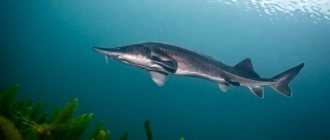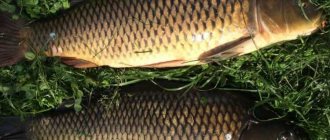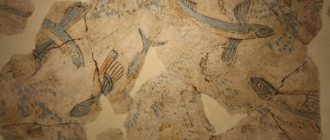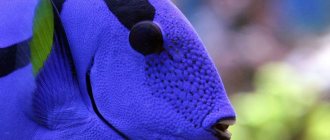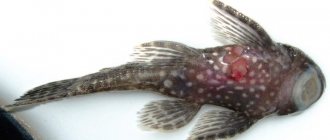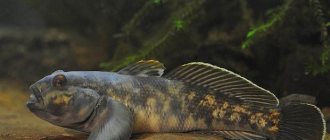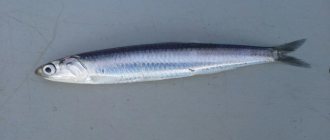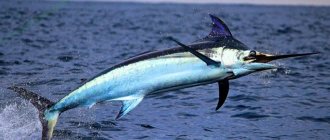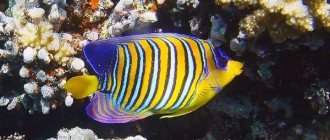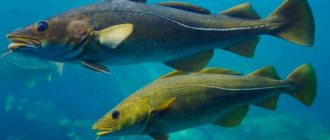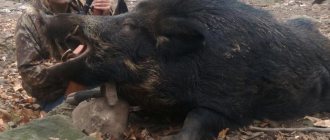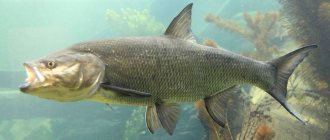The Karpov family has about 2 thousand species. Among them there is also a prominent representative - grass carp (belamur, water cow, grass carp). Large, beautiful fish quickly adapt to the new environment of the reservoir.
Valued for clearing unwanted vegetation. Today, their population has decreased significantly. This means that the fish is endangered. Therefore, artificial reproduction is increasingly occurring.
| Class | Ray-finned (Bone) |
| Squad | Carp-like |
| Family | Carp |
| Genus | White cupids |
| View | white cupid |
| Security status | Doesn't have |
| The average size | 110-120 cm |
| Lifespan | 15-16 years old |
| What does it eat? | Aquatic vegetation |
| Optimal feeding time | Morning, afternoon and evening |
| Enemies | Predator fish (catfish, pike), humans, birds, some insects and amphibians |
| What do they bite on? | Corn, aloe leaves, pea leaves, cherry, plum, reeds, cabbage, cucumber |
Description of grass carp
Plant carp is a large individual. With a body length of 100-120 cm, weight can reach up to 40 kg. Wikipedia describes a case when the weight of the fish was 45 kg and the body length was 150 cm. In photos from fishing, which fishermen post a lot on the Internet, the weight of the trophy can reach 16 kg or more.
The weight of grass carp can reach 40 kg.
Appearance
Amur carp has a large body, which is slightly flattened on the sides and elongated in the shape of a small cylinder. All scales are large, fit tightly to the body of the individual and have a black rim. The color of the scales changes: on the back it is gray-green, closer to the sides it is a light shade, sometimes with yellowness, the abdomen is white.
The head is small with a wide, slightly flattened forehead and golden eyes. In images of Amur carp you can see that the edge of the jaw reaches the beginning of the orbit of the eye. Sharp teeth are located in the throat.
The dorsal and pelvic fins are located on the same vertical. The dark caudal fin has a notch. The pectoral fins are located near the gills, which are decorated with rainbow stripes.
White amur.
Tips for successful fishing
Experienced fishermen give some valuable tips on how to catch grass carp faster:
- place the prepared bait near the grass,
- clean a small area of water yourself by creating special “windows”,
- start fishing late at night, when there is less noise on the coast.
- Feed the fish several days in advance before fishing.
The most successful days for catching carp are warm, clear and windless days.
Distribution and habitats
The distribution of white carp originates in the rivers:
- Far East (Amur basin);
- East Asia (China and northern Vietnam).
White fish is vegetarian. She prefers to eat plant foods and easily tolerates low (high) temperatures. Therefore, it was brought to many countries to combat aquatic vegetation in reservoirs, ponds, and irrigation canals. It has adapted to new conditions, and now the Volga, Dnieper, Don, Kuban, Ural rivers and reservoirs have become home for this individual:
- Moldova;
- Ukraine;
- Belarus;
- Kazakhstan;
- European part of Russia;
- USA
- and other countries.
How to look for fish?
Grass carp is a cautious fish. She prefers places heavily overgrown with vegetation, snags, and fallen trees. There she feels safe and eats algae, sitting in ambush. Amur is a heat-loving river inhabitant, therefore it loves not too deep waters (no more than 4 meters) and areas well warmed by the sun.
This fish leads a schooling lifestyle. She often looks for food near the surface, leaving splashes on the water, grabs and pulls the stems of reeds, setting them in motion. Sometimes it can even jump out of the water after a fallen leaf. But such careless behavior is more typical of carp in a pond artificially stocked with them.
Character and lifestyle
In the warm season, the main condition for the existence of plant carp is the presence of aquatic plant food in the river.
At temperatures above +24ºС this species is in an active state. Cows graze a lot, grow and reproduce.
As temperatures drop, living conditions change dramatically. They stop feeding on aquatic vegetation, gather in large flocks and are buried in holes in rivers and ponds, where at a temperature of +5ºС they fall into complete torpor. The special mucus that the bodies of cupids secrete protects against cold temperatures and is visible on the surface of the reservoir.
White carp feeds mainly on plant foods and easily tolerates low (high) temperatures.
Food of grass carp
Amur carp has another name, water cow. A condition for the active growth of individuals of this species is the presence of aquatic vegetation in rivers and ponds; they need:
- Characeae algae;
- soft grass;
- duckweed;
- chilim;
- reed;
- rdest, etc.
Terrestrial vegetation includes clover, alfalfa, and cereals.
In the first period of life, all young individuals feed heavily on zooplankton and small crustaceans, but when they reach a length of 6-10 cm, they completely switch to aquatic plant food.
If there is little vegetation in the reservoir, then the Amur cow can feed on crustaceans, mollusks, worms, and insects. And in the hungry season, caviar, fish larvae, and fry can become food.
Basic diet
Grass carp feeds on vegetation and eats various types of algae. The anatomical feature of the fish is its small intestine. The food is quickly digested and the river dweller becomes hungry again.
The river inhabitant is actively gaining weight, growing by 1.5-2 kg per year. If there is little algae in the reservoir, the fish eats:
- thread;
- small river insects;
- moths;
- shellfish;
- duckweed
Hungry grass carp can eat fry and eggs. In the process of artificially breeding this fish, fresh grass and crushed reeds are constantly thrown into the water so that the cupids do not starve and do not reduce the number of neighbors in the reservoir.
Age, size and spawning
In the Far East, plant carp are ready for reproduction at the age of 10 years (weighing 6-7 kg); in rivers of more southern regions, spawning can begin as early as 5 years (weighing 5-6 kg) or earlier.
A signal that male Amur cows are ready to breed is a pearl rash on the dorsal and pectoral fins, sometimes on the upper side of the tail. In females of this species the changes are little pronounced.
The spawning conditions for belamur are:
- high temperature - about +26ºС;
- River flow;
- a large amount of plant-based aquatic food;
- absence of noise and threat to life.
If the conditions for reproduction are unsuitable: low temperature in the reservoir, heavy rains or drought, lack of aquatic plant food, the female carp may not spawn. All eggs dissolve in it over time.
In the Far East, grass carp are ready to spawn at the age of 10 years and weigh 6-7 kg.
After 1.5-2 days, small larvae appear from the fertilized eggs, for which the yolk sac is the only source of food. In 7-10 days, a small individual becomes a fry, the length of which is about 9 mm. The Amur fry lives in shallow water bodies and feeds on zooplankton and benthos. Having reached 3 cm, the individual can completely switch to the aquatic vegetation of rivers.
Growing in an artificial environment
In order to raise grass carp, it needs to create conditions close to its natural habitat. This species of Carp is bred in fish farms. To do this, the right conditions are created for life, and most importantly, for reproduction. The water should be 25-26C° with an artificial current.
To speed up puberty, individuals are given a special injection from extracts of the pituitary fluid of carp (you can use crucian carp). Dosage for males is 2 mg, for females 4 mg (first dose 10%, second 90% after 3 hours).
The very next day, milk and caviar are expressed into a wide bowl. Stir with a goose feather and water with water from the reservoir where the fry will further develop. The water is then drained and fresh water is added again. Stir with a feather until the fertilized eggs begin to swell and increase in size. In this case, the bottom of the container should be lowered into a pond or aquarium to stabilize the temperature.
After 1.5 hours, the eggs will be placed in a special Weiss apparatus. There, in running water, further development occurs over 4 hours. After the fry hatch, dead eggs and membranes must be removed.
Live fry are planted in small cells (up to 1 mm). The cages should be placed in a pond or pool. The water temperature is gradually increased. The first three days are 22C°, the next 5 days are already 23-24C°, and another 3 days are 30C°.
This time is enough for adaptation and to start swimming horizontally. Babies feed on zooplankton. You can feed it with cottage cheese, egg yolk and daphnia. They are released into the pond after active feeding begins.
Enemies of white cupids
Adults of this plant species are large in size, so they have no enemies. But before all the eggs, fry, small individuals reach large sizes, they can be food for
- many animals, aquatic and terrestrial;
- amphibians, insects;
- all predator fish;
- birds that live near rivers and ponds.
Sudden changes in weather conditions: low temperatures, heavy rains, drought threaten the reproduction process of individuals of this species, the maturation of eggs, and the development of fry and young fish.
Population and species status
Fish is valued for its large weight and tasty meat. Under natural conditions, the number of Amur individuals is small, so artificial breeding contributes to the spread of the species in rivers and ponds around the world. The cow quickly adapts to new living conditions.
The water cow is the best land reclamation agent. Therefore, it can serve in many reservoirs as a natural purifier of excess aquatic vegetation for ponds at state district power plants, thermal power plants, nuclear power plants, etc.
Grass carp quickly adapts to new living conditions and can serve as a natural cleanser of excess aquatic vegetation.
Feed ratio
The feed coefficient of aquatic vegetation is 20-70, terrestrial plants - 20-30, and artificial feed - 5-8, i.e. it is higher than that of carp. Therefore, feeding grass carp in a pond is unprofitable.
You can read how to grow grass carp in a pond here.
zavidovo.kz
grass carp
, or
grass carp
, is a typical river fish and resembles a chub.
Body
elongated in length, cylindrical in shape, slightly flattened at the sides. The color is light green, darker on the back, whitish on the belly. The rear, free edges of the scales are dark, the body is patterned, as if dark crescents are placed on it one next to the other. The back of the mouth falls away a little. The pharyngeal teeth are compressed, their crowns are saw-shaped.
In their original homeland, in Chinese rivers, 10-15 year old fish reach a mass of 50 kg.
Nutrition
. Juvenile grass carp initially feed on zooplankton. At a length of 6-10 cm, when the intestines become longer, it switches to plant foods. The final ratio between the length of the trunk and intestines ranges from 1:2 to 1:2.5. Grass carp is primarily a herbivorous fish. However, like carp, it sometimes eats young fish. He is unpretentious and willingly eats food intended for carp in the pond. Among plants, he prefers filamentous grass and soft grass, but does not refuse hard charophyte algae, hornwort, duckweed, reed leaves, etc.
Grass carp does not eat the hard stems of the yellow iris, it only partially consumes the hard stems of the cattail, it does not like amphibian buckwheat and the flaccid buttercup. He loves food that can be obtained without much difficulty, so he prefers thin soft stems, as well as cut leaves of reeds. If there is no favorite food, it becomes indiscriminate: it grabs emergent plants and with one jerk tears them out of the soil. He eats most of them and spits out the rest. Pieces of plants floating on the surface, bitten off at one end, are the result of the “activity” of grass carp.
In an aquarium, food intake stops almost at a temperature of 12° C. The optimal feeding temperature for grass carp is 25-30° C. At this temperature, it can eat 100-120% of its weight in food every day. Food is digested quickly, so some of the nutrients are not used, especially when the fish eat pelleted feed. Semi-digested food is an excellent fertilizer and partly also food for carp. In winter, grass carp does not feed at all.
Height
. Grass carp grows quickly. The hatched larvae are 5.0–5.5 mm long. At a length of 8.0–8.5 mm, it begins to actively feed. The weight of young white carp under favorable conditions is 40 g, and two-year-olds - 600 g. Three-year-olds reach 1500 g, and four-year-olds - 3300 g. The growth of fish depends on water temperature, stocking density and the availability of food.
Planting Density
. Stocking density and food availability are interrelated: the more vegetation in the pond, the more grass carp should be planted. Productivity, depending on the oxygen content in the water and nutrition during the growing period, is approximately 50-1000 kg/ha.
Being together in the same pond, carp and grass carp should not be competitors for food. With appropriate planting, carp eats its food, and grass carp eats green plants. Planting grass carp is then profitable when the productivity of the pond increases significantly. Planting that corresponds to the norm occurs when grass carp, at a water temperature of 18-20 ° C, can daily eat 60-120% of its mass of green plants. If there is only tough emergent vegetation in the pond, then grass carp should eat 30-60% of its body weight daily. If there is no vegetation, then you should either reduce the amount of grass carp or feed it. The daily feeding rate is 3-4% of the fish’s weight. As feed, you can use the usual feed mixtures accepted in carp farming.
Feed ratio
. The feed coefficient of aquatic vegetation is 20-70, terrestrial plants - 20-30, and artificial feed - 5-8, i.e. it is higher than that of carp. Therefore, feeding grass carp in a pond is unprofitable.
Grass carp produces significant additional production, so it is a favorable additional fish in a carp pond. In order for grass carp to immediately get used to green food, it should be fed with this food immediately after stocking. If there is no food, then land plants are brought in. An excellent mixture is a mixture of clover varieties, which is mowed along the slopes of the pond.
www.activestudy.info
Features of artificial breeding
Breeding the Amur carp species is beneficial for several reasons:
- The meat is tasty and has high nutritional value (fat content up to 8%).
- High rate of growth and weight gain.
- Can eat any plant food.
- The maximum weight can reach 40 kg.
- Withstands low and high temperatures well.
- Not susceptible to many infectious diseases.
- Gets along well with other carp and does not compete with them for food.
- Clears ponds of excess aquatic vegetation.
Previously, in order to maintain the population of water cows in artificial reservoirs, many larvae were caught from rivers and planted in the pond. Now the technology has changed: a person himself fertilizes individuals and raises fry, creates the necessary temperature and controls the availability of plant food, and carries out the necessary feeding.
Yolk and cottage cheese are used to feed the larvae. Fingerlings are supplemented with soy, vegetable mixtures and mixed feed. All adult individuals can feed on the same aquatic vegetation; terrestrial vegetation is added as supplementary food.
Release of white carp fry.
Breeding in a home pond
White carp is a breed of plant-eating fish, the breeding of which brings significant profits. This variety of carp is quite unpretentious, gains weight well and is highly resistant to various diseases. Some specimens can reach a weight of over 25 kilograms.
To grow carp in a home pond, you first need to purchase breeding material obtained from larvae. From the day of hatching until the age of one month, the fry are raised in a separate pond with good bait. The best food for them is zooplankton. If it is not possible to breed breeding material yourself, then fry can be purchased at fish farms.
The fry should be kept in a pond of approximately 100-150 m². In reservoirs of this size it is easier to control the growth of fry. After a month, they grow to 30 centimeters, after which they can be moved to a pond with an area of 500 m².
The water containing cupid must be heated to 25-30˚C. Another important condition is the availability of a good food supply. Dry food must be mixed with greens. When these requirements are met, the fish grows quickly and gains weight.
Yandex pictures
Period and places of fishing
In early spring there are no suitable conditions for fishing for Amur carp (low temperature). In the second half, as the temperature rises, the activity of individuals increases. There are few aquatic plants and the water cow spends a lot of time looking for food, so proper feeding and strong gear can bring a good catch.
In summer people go fishing in the morning in any windless weather. All places on the reservoir overgrown with aquatic vegetation are suitable for fishing. In the autumn, the best conditions for fishing will be warm weather, because when the temperature drops, the activity of the species in the river decreases, and the fish stop feeding on plant foods.
A careless sound can cause the fish to go deeper into the pond or look for other areas with vegetation.
The Amur cow prefers to graze in the upper layers of the reservoir, where the water temperature is higher.
What to catch grass carp with
The water cow is a herbivorous river animal that prefers to feed on aquatic and terrestrial vegetation, but in times of famine it becomes omnivorous. The main task of the fisherman is to keep it at the fishing point, so it is necessary to create conditions suitable for this plant species:
- silence;
- suitable bait;
- new, strong tackle and sharp hooks (to withstand heavy weight).
Groundbaits and lures
Baits are needed to keep the fish on the spot for a long time. The cloud of turbidity, the aroma of the mixture will attract the water cow to the fishing spot, the nutritious ingredients will give it food.
Suitable bait mixture ingredients:
- bread;
- grains of young and canned corn;
- boiled potatoes;
- porridge (barley, millet);
- crackers;
- powdered milk;
- chopped watermelon rinds, zucchini, cabbage leaves;
- semolina;
- condensed milk;
- honey.
The fish must be fed periodically, so you need to have a lot of mixture in reserve (at least 3 kg). The more aromatic the mixture, the easier it is to attract an Amur cow.
Fishing stores offer a large selection of complementary foods:
- technoplankton;
- "Geyser" and "Vulcan";
- pellets;
- boilies.
The bait for the water cow is both aquatic plants: stems of young reeds, reeds, and terrestrial ones - fresh cucumber ovary with a flower, young cabbage leaf, dandelion leaf. In the spring, when there is little natural plant food in the reservoir, it can peck at anything: worms, bloodworms, maggots.
Tackle
Young individuals of this species can be caught well with a simple fishing rod, but an adult requires strong equipment.
Match tackle. Allows you to fish at large distances (15-70 m) from the shore and at different depths of the reservoir. Pros: reel with friction brake (for heavy weights), running float.
| Rod length | 3.5-4 m |
| Spinning reel with spool | 4000 |
| Line diameter | <0.3 mm |
| Hook | №7-10 |
Feeder tackle. One of the donkey options allows you to catch grass carp and feed it. The rod tip is highly sensitive. The main condition for a large catch is that the bait is higher than the bottom vegetation; for this, a small piece of foam is used.
| Rod length | 3-3.5 m |
| Spinning reel with spool | 3000-3500 |
| Line diameter | 0.3-0.4 mm |
| Hook | №8-10 |
Plug tackle. Carp plugs are suitable for catching large, heavy specimens. The fishing rod is heavy, but allows for precise casting. Good on river flows and in still water.
| Carp rod | up to 13 m |
| Line diameter (depending on the thickness of the shock-absorbing rubber) | 0.2 mm (with a thickness of 2 mm) |
| Hook | №5-10 |
Fishing calendar
The biting activity of grass carp is quite predictable, so experienced fishermen have long been able to make a bite forecast. Well, for those who have less experience behind them, we suggest looking at the grass carp biting calendar and using it to choose days for fishing. Click image for a larger view.
January
January is a slow month for catching grass carp. The likelihood of a fish biting is reduced to zero. We can safely say that he does not bite.
February
In February, carp activity is not observed. The fish don't bite at all.
March
With the onset of spring warmth, the fish begin to wake up, but in March, carp bite very rarely. His capture can be considered a great success
April
The warmth of April awakens the carp after hibernation, but the fish still remains passive and reluctantly takes the offered bait.
May
If in your region in May the water temperature reaches 12-16 degrees, then carp begins to be caught very well.
June
In June, fishing for grass carp begins to bring the desired results. It is in this month that the fish bite best.
July
In July, cupid begins to eat. Fishermen note the active and steady bite of this fish.
August
With the onset of August, grass carp's feeding does not stop. The use of float gear for catching carp becomes relevant in the second half of August.
September
In September, the hunger subsides, and with it the bite. But it is still possible to catch cupid, although it is a little more difficult than in summer.
October
In October, carp continue to be actively caught using float gear until the water temperature drops below +12°C.
November
In November, carp show virtually no activity, and most of the flocks go to wintering pits, from where they never leave.
December
In December, fish stay in wintering pits and catching carp is a rarity. So it is not advisable to go to the Amur in winter.
Techniques and tactics of catching grass carp
The result of fishing depends on the noiselessness of the fisherman’s actions. Vegetable carp is a type of schooling fish, so good bait can give a large catch and a large weight of the trophy. The bait mixture is given in parts; it is impossible to overfeed a water cow, but the lack of food will force it to leave.
Time of hooking and landing
The Amur carp eats the pieces of food it likes with its large lips. The lower jaw is more developed, so a large hook is needed to catch it, otherwise it may break off.
Having swallowed the bait, the water cow begins to hook itself. The main condition is not to let the catch go into the vegetation, so the line should be kept taut. Without allowing the prey to rest, direct it to the shore of the reservoir. From the moment of hooking to retrieving it can take 10 minutes or more.
Planting Density
Stocking density of grass carp and dense planting of natural food is very important. The more vegetation in the pond, the more grass carp should be planted. Productivity depends on the oxygen content in the water and nutrition during its cultivation ranges from 50 – 100 kg/ha.
When in the same pond as common carp, grass carp and carp should not compete for food. Planting grass carp is cost-effective when pond productivity increases. If there is no natural food, the amount of grass carp in the pond should be reduced.
Composition of grass carp
This form contains:
- protein that is quickly absorbed by the human body;
- rich spectrum of vitamins - B, A, C, E, PP, D;
- Omega-3, 6 fatty acids, which have the most beneficial effect on cells, tissues, and blood vessels.
Its meat contains a large number of microelements:
- potassium;
- phosphorus;
- sodium;
- magnesium;
- calcium;
- zinc;
- iron;
- copper;
- selenium;
- manganese.
Composition, benefits and harms of meat
The meat of this fish does not contain much fat. It contains the following valuable components:
- potassium;
- calcium;
- phosphorus;
- zinc;
- B vitamins;
- proteins.
100 g of product contains only 120 kcal. Herbal carp provides prevention of vitamin deficiency and is indicated for people with pathologies of the heart and thyroid gland. Despite the benefits, the meat of this fish can be harmful in case of individual intolerance to the components and chronic liver diseases, which can worsen with frequent consumption of this product.
Use in cooking
White carp meat is a universal product, so it can easily be processed in different ways. And the dishes always look appetizing.
Cooking
A traditional fisherman's dish made from river fish is fish soup.
Ingredients:
- White amur;
- onion - 1 pc.;
- potatoes - 2-3 pcs.;
- carrots - 1 pc.;
- salt, pepper, bay leaf.
Grass carp ear.
Recipe:
- The carcass should be thoroughly cleaned, so scales, fins, entrails and gills are removed.
- The fish is cut into small pieces and a little salt is added.
- Before placing it in boiling water, wash it again, removing excess salt and remaining mucus.
- Add an onion, finely chopped or whole (to taste), to boiling water.
- Add large potato cubes and carrots, whole or coarsely chopped. Cook everything over low heat until the potatoes are completely cooked.
- Add pieces of meat and cook for about 20 minutes.
- Add salt and spices, close the lid and remove from heat. Let it brew.
Baking
There are many recipes for baked cupid on the Internet. For example.
The carcass is washed well, gutted, cleaned of entrails, and the gills are removed. The finished carcass is salted with coarse salt, spices are added, sprinkled with lemon juice, wrapped in foil and placed in the oven for 30-45 minutes at a temperature of 180-200º.
The Amur delicacy dish is ready to eat, while all the vitamins and many useful substances are preserved. Suitable for people watching their weight.
Grass carp baked in foil.
Frying
The product contains fat, so after frying the dish remains juicy, but its calorie content increases. Therefore, it is not recommended for people who have health problems or are overweight.
Algorithm:
- Prepare the product: remove scales, remove entrails and gills.
- Cut the carcass into pieces.
- Salt all the pieces with coarse salt, add spices to taste, sprinkle with lemon and leave to marinate for 15 minutes.
- Roll the pieces in breadcrumbs or flour.
- Fry in a well-heated frying pan over high heat until a crust forms.
Pickling
The condition for good salting is fresh fish, just caught from the reservoir.
They gut the carcass, trying not to damage the internal organs, remove the gills, and wash them well. A large specimen for pickling is cut into large pieces. Small - salted whole.
For salting, fish is cut into large pieces and rubbed with coarse salt without additives.
All pieces are rubbed with coarse salt without additives. Then a layer of pieces is placed tightly on the bottom of the container, a lot of salt is added and the next portion is added. The steps are repeated until all pieces of meat are in the container.
A wooden circle or lid is placed on top, which fits freely into the container. Install heavy oppression. Place in a cool place.
After a few days you can try the delicacy.
Photos of grass carp
All fishermen strive to take pictures with their catch against the backdrop of a river or reservoir. Photos with an Amur cow are proof of the skill of the fisherman.
This specimen of grass carp weighs more than 20 kg.
Happy fisherman.
It seems that this fisherman still does not believe that he caught such a giant.
What baits does it respond to?
Grass carp prefers bait of plant origin. Since the fish belongs to the carp family, it can be caught using the same baits as carp:
- boilies;
- peas;
- corn;
- Hercules;
- pearl barley;
- dough, etc.
In addition to these classic baits, the following are great for catching grass carp:
- cabbage;
- cucumber;
- bean pods;
- seaweed;
- dandelion stems and leaves;
- aloe, etc.
Among animal baits you can try:
- Maggot.
- Worm.
- Bloodworm.
Please note that the likelihood of catching a large specimen using animal bait is not very high. If a river vegetarian has enough natural food, he is unlikely to try various delicacies.
